
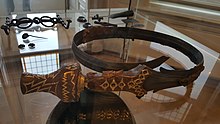
The Vorstengraf ( grave of the king) in Oss is one of the largest burial mounds in the Netherlands and Belgium. The hill was 3 metres high and had a diameter of 54 metres.


The Vorstengraf ( grave of the king) in Oss is one of the largest burial mounds in the Netherlands and Belgium. The hill was 3 metres high and had a diameter of 54 metres.
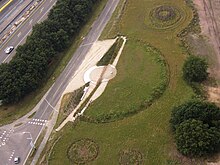
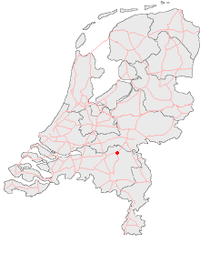
In 1933, the so-called Vorstengraf was uncovered during the construction of a trailer park on the heath. It contained a bronze cauldron containing a curved iron sword from 700 BC. The find was transferred to the Rijksmuseum van Oudheden in Leiden. The site of the hill was later a junkyard. The mound is now partly restored, a portion of the circumference of the hill is marked with poles.
In 2009, a second Vorstengraf was discovered a few hundred metres from the first Vorstengraf. The finds from this tomb are displayed in the Jan Cunen Museum in Oss. In 2011, it was announced that a third Vorstengraf was discovered in Uden.
The Vorstengraf is located at the interchange Paalgraven. This node is named after the pile graves that have been found in the immediate vicinity. These tombs were built in the period of the Early Bronze Age to the Early Iron Age (Hallstatt culture), between 2000 BC to 700 BC.
To the east of Oss a new highway was built to connect the A50 and A59 from Emmeloord to 's-Hertogenbosch (formerly the junction with the N265 Eindhoven-Oss).
In the vicinity of the tomb two Forest Hills Tree Wreaths were excavated. According to archaeologists the poles probably had a ritual function. One of the hills is surrounded by a ditch.
To the east and south of the Vorstengraf an urnfield was found dating back to the Late Bronze Age and Early Iron Age. Cremated remains are interred in an urn or cloth. Soon after the establishment of the Vorstengraf the burial ground was closed.
The area De Zevenbergen - Seven Mounds - was examined in 1964 and 1965 and seven burial mounds were found. When the junction was later modified the area had another investigation. Trial slots revealed that there had been a line of poles over a length of at least 100 meter in the area. In 2004 began the actual excavation of the multiple burial hills.
In the 13th century a gallows was built on one of these hills. This was at a crossroads of continuous ruts on the heath and the remains of two victims were found nearby.
There are folk tales associated with the mound, local historian Jan Cunen (1884-1940) once recorded that a prince must have been buried in the heath.
The hill is also called Hansjoppenmountain. There are several stories about the Gnome Hans Joppen.

A kurgan is a type of tumulus constructed over a grave, often characterized by containing a single human body along with grave vessels, weapons and horses. Originally in use on the Pontic–Caspian steppe, kurgans spread into much of Central Asia and Eastern, Southeast, Western and Northern Europe during the 3rd millennium BC.

A tumulus is a mound of earth and stones raised over a grave or graves. Tumuli are also known as barrows, burial mounds or kurgans, and may be found throughout much of the world. A cairn, which is a mound of stones built for various purposes, may also originally have been a tumulus.

The Hallstatt culture was the predominant Western and Central European culture of Late Bronze Age from the 12th to 8th centuries BC and Early Iron Age Europe from the 8th to 6th centuries BC, developing out of the Urnfield culture of the 12th century BC and followed in much of its area by the La Tène culture. It is commonly associated with Proto-Celtic populations. Older assumptions of the early 20th century of Illyrians having been the bearers of especially the Eastern Hallstatt culture are indefensible and archeologically unsubstantiated.
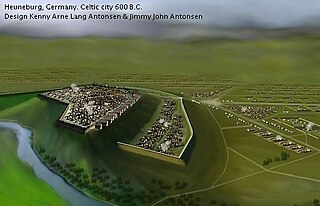
The Heuneburg is a prehistoric hillfort by the river Danube in Hundersingen near Herbertingen, between Ulm and Sigmaringen, Baden-Württemberg, in the south of Germany, close to the modern borders with Switzerland and Austria. It is considered to be one of the most important early Celtic centres in Central Europe. Apart from the fortified citadel, there are extensive remains of settlements and burial areas spanning several centuries.

A gallery grave is a form of megalithic tomb built primarily during the Neolithic Age in Europe in which the main gallery of the tomb is entered without first passing through an antechamber or hallway. There are at least four major types of gallery grave, and they may be covered with an earthen mound or rock mound.

Bant's Carn is a Bronze Age entrance grave located on a steep slope on the island of St Mary's in the Isles of Scilly, England. The tomb is one of the best examples of a Scillonian entrance grave. Below Bant's Carn, lies the remains of the Iron Age village of Halangy Down.
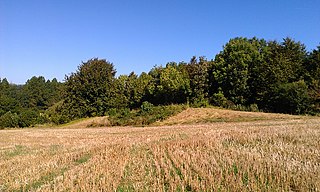
Julliberrie's Grave, also known as The Giant's Grave or The Grave, is an unchambered long barrow located near to the village of Chilham in the south-eastern English county of Kent. Probably constructed in the fourth millennium BCE, during Britain's Early Neolithic period, today it survives only in a state of ruin.

The Mound of the Hostages is an ancient passage tomb located in the Tara-Skryne Valley in County Meath, Leinster, Ireland.
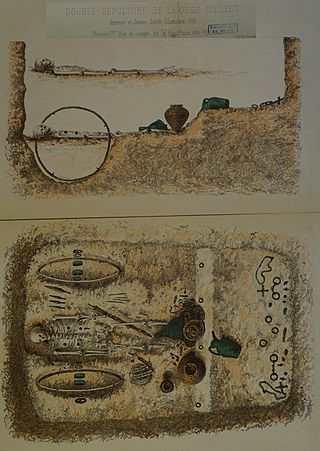
Chariot burials are tombs in which the deceased was buried together with their chariot, usually including their horses and other possessions. An instance of a person being buried with their horse is called horse burial.
Merheleva Ridge is the site of an Eneolithic temple and burial complex consisting primarily of four large stone mounds or kurgans situated near Perevalsk, Luhansk oblast, Ukraine, about 30 km to the west-to-southwest of the city of Luhansk. "Merheleva" is the Ukrainian adjective from the word merhel, marlstone, which is a type of limestone common in the region. Supposedly the site was built in about 4000 BC, corresponding to the Dnieper-Donets or early Yamna culture, and remained in use throughout the Bronze Age and well into the Iron Age, until 5th century BC Sarmatia. It was discovered in 2004, and the discovery officially announced on 7 September 2006.

The Vix Grave is a burial mound near the village of Vix in northern Burgundy. The broader site is a prehistoric Celtic complex from the Late Hallstatt and Early La Tène periods, consisting of a fortified settlement and several burial mounds.

The dolmens of Jersey are neolithic sites, including dolmens, in Jersey. They range over a wide period, from around 4800 BC to 2250 BC, these dates covering the periods roughly designated as Neolithic, or “new stone age”, to Chalcolithic, or “copper age”.
The European Archaeological Park at Bliesbruck-Reinheim, in the German municipality of Gersheim (Saarland) and the French municipality of Bliesbruck, is a cross-border project which combines excavations and reconstructions of Celtic and Roman finds with exhibition and educational facilities. It was created in 1989 as a result of the archaeological work being done on both sides of the Franco-German border. Together with archaeological evidence from the Mesolithic Period, the Bronze Age, and the period of the Germanic migrations, the Celtic and Roman finds from the Iron Age bear witness to a history of continuous settlement in the Blies Valley that spans a period of 10,000 years.

The Leubingen tumulus is an early bronze age "princely" grave of the Leubingen culture,, dating to about 1940 BC. It is located near the hills of Kyffhäuser in Leubingen, an Ortsteil of Sömmerda in the eastern German state of Thuringia.

Eston Nab is a rocky outcrop hill in the town of Eston, Redcar and Cleveland, North Yorkshire, England.

The Street House Anglo-Saxon cemetery is an Anglo-Saxon burial ground, dating to the second half of the 7th century AD, that was discovered at Street House Farm near Loftus, in the unitary authority of Redcar and Cleveland, England. Monuments dating back as far as 3300 BC are located in the vicinity of the cemetery, which was discovered after aerial photography revealed the existence of an Iron Age rectangular enclosure. The excavations, carried out between 2005 and 2007, revealed over a hundred graves dating from the 7th century AD and the remains of several buildings. An array of jewellery and other artefacts was found, including the jewels once worn by a young high-status Anglo-Saxon woman who had been buried on a bed and covered by an earth mound.
Part of series of articles upon Archaeology of Kosovo
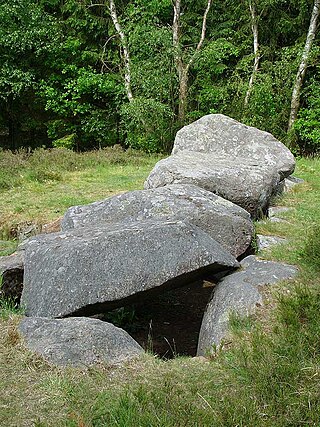
The Necropolis of Soderstorf is a prehistoric cemetery in the valley of the Luhe river valley near Soderstorf in the Lüneburg district of Lower Saxony, Germany. The site was used for more than 2000 years. It includes a megalithic tomb, a tumulus tomb, a stone circle, paving stones, funerary urns and a flat grave.

The Scythian culture was an Iron Age archaeological culture which flourished on the Pontic-Caspian steppe in Eastern Europe from about 700 BC to 200 AD. It is associated with the Scythians and other peoples inhabiting the region of Scythia, and was part of the wider Scytho-Siberian world.

Quanterness chambered cairn is a Neolithic burial monument located on Mainland, Orkney in Scotland. An Iron Age roundhouse built into the cairn was discovered during excavation in the early 1970s. The dwelling was constructed around 700 BC. Also found during excavation, were the remains of 157 people, pottery remnants and other artefacts. Historic Environment Scotland established the site as a scheduled monument in 1929.